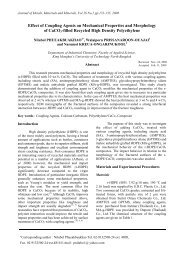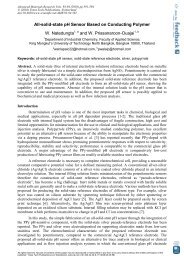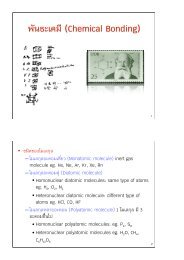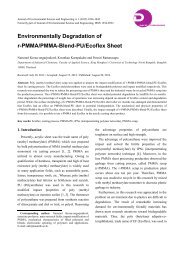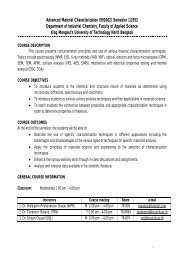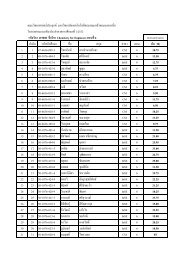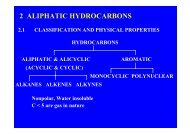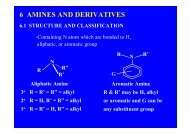Poly(2,5-dimethoxyaniline) based pH sensors Nophawan Paradee ...
Poly(2,5-dimethoxyaniline) based pH sensors Nophawan Paradee ...
Poly(2,5-dimethoxyaniline) based pH sensors Nophawan Paradee ...
Create successful ePaper yourself
Turn your PDF publications into a flip-book with our unique Google optimized e-Paper software.
NU Science Journal 2009; 6(S1) 88<br />
Survey and high-resolution region spectra were recorded at analyzer pass energies of<br />
160 eV and 20 eV, respectively. A low-energy electron flood source as used to<br />
counter surface charging during spectral acquisitions, and spectra were corrected for<br />
charge shifting by referencing to the C–C component of the C 1s peak<br />
(E b = 285. eV).<br />
Potentiometric measurements were conducted using a 2700 digital<br />
multimeter/data acquisition system (Keithley, USA). The PDMA-modified electrode<br />
was conditioned in 0.1M oxalic acid overnight and rinsed thoroughly with deionized<br />
water before use as an indicating electrode. Standard buffer solutions of different <strong>pH</strong><br />
values were prepared with appropriate mixtures of citric acid (Ajax), boric acid<br />
(Ajax) and Na 3 PO 4 .10H 2 O (Sigma-Aldrich) (Perrin and Dempsey, 1974). The opencircuit<br />
potentials (E cell ) of the electrode were recorded against an Ag/AgCl reference<br />
electrode. A calibration curve was constructed by plotting the E cell (mV), against the<br />
<strong>pH</strong> value of the buffer solution. Electrode selectivity was evaluated in the presence<br />
of various interfering ions following the IUPAC recommendation that the interfering<br />
ion concentration was kept constant at 0.01 M and the <strong>pH</strong> was varied. The<br />
selectivity coefficient (K ij ) was estimated using the extended Nernstian equation<br />
(Buck and Linder, 1994). The electrode stability was monitored by repeatedly<br />
introducing the electrode into the buffer solutions, measuring the potentials and<br />
storing the electrode in the conditioning solution.<br />
RESULTS AND DISCUSSION<br />
1. Surface Characterization of the PDMA-modified Electrodes<br />
Typical XPS survey spectrum for the PDMA surface is presented in Figure<br />
1 showing the expected elemental composition of PDMA including carbon, oxygen<br />
and nitrogen. No signal of stainless steel electrode could be detected indicating<br />
complete coverage of PDMA.<br />
x 10 4<br />
10<br />
O 1s 1s<br />
8<br />
C<br />
1s<br />
1s<br />
CPS<br />
6<br />
4<br />
C KLL<br />
O KLL<br />
N 1s<br />
2<br />
1400 1200 1000 800 600 400 200 0<br />
Binding Energy (eV)<br />
Figure 1 Typical XPS survey spectrum for PDMA surface




